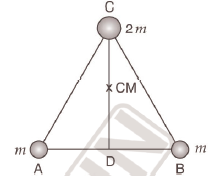Two balls each of mass m are placed on two vertices of an equilateral triangle. A ball of mass 2 m is situated at the third vertex. Determine the centre of mass of the system.
 Solution in Punjabi
Solution in Punjabi
Step by step video & image solution for Two balls each of mass m are placed on two vertices of an equilateral triangle. A ball of mass 2 m is situated at the third vertex. Determine the centre of mass of the system. by Physics experts to help you in doubts & scoring excellent marks in Class 11 exams.
Updated on:21/07/2023Topper's Solved these Questions
- Centre of massBOOK - MODERN PUBLICATIONCHAPTER - Centre of massEXERCISE - Exercise
30 Videos
- Acceleration due to gravityBOOK - MODERN PUBLICATIONCHAPTER - Acceleration due to gravityEXERCISE - Exercise
29 Videos
- Competitive Exam QuestionBOOK - MODERN PUBLICATIONCHAPTER - Competitive Exam QuestionEXERCISE - Exercise
301 Videos
Similar Questions
What is centre of mass of a system?
View SolutionState Keplers' laws of planetary motion.
View SolutionGive the magnitude and direction of the net force acting on:- a drop of rain falling down with a constant speed.
View SolutionIf origin and 2-i are two vertices of an equilateral triangle,then determine the third vertex.
View SolutionA ball of mass M is thrown vertically upwards. Another ball of mass 2M is thrown at an angle θ with the vertical. Both of them stay in air for the same period of time. The heights attained by the two are in the ratio
View SolutionTwo balls of mass m each are placed at the two vertices of an equilateral triangle. Another ball of mass 2m is placed at the third vertex of the triangle. Locate the centre of mass of the system.
View SolutionIf two particles each of mass m are placed at the two vertices of an equilateral triangle of side a , then the resultant gravitational force on mass m placed at the third vertex is
View SolutionTwo lead balls of mass m and 2 m are placed at a separation d. A third ball of mass m is placed at an unknown location on the line joining the first two balls such that the net gravitational force experienced by the first ball is (6Gm^(2))/(d^(2) . What is the location of the third ball?
View SolutionThree identical particles each of mass m are placed at the vertices of an equilateral triangle of side a. Fing the force exerted by this system on a particle P of mass m placed at the (a) the mid point of a side (b) centre of the triangle
View SolutionThe balls A, B and C of masses 50 g, 100 g and 150 g, respectively are placed at the vertices of an equilateral triangle. The length of each side is 1 m. If A is placed at (0, 0) and B is placed at (1, 0) m, find the coordinates (x, y) for the centre of mass of this system of the balls
View SolutionThree balls A,B and C of masses 50 g , 100 g and 150 g respectively are placed at the verticles of an equilateral triangle . The length of each side is 1 m . If A is placed at (0,0) and B is placed at (1,0) m , find the coordinates , (x,y) for the centres of mass of this system of balls
View SolutionIf two particles each of mass m are placed at the two vertices of an equilateral triangle of side a, then the resultant gravitational force on mass m placed at the third vertex is
View SolutionThree particles of masses 1 g, 2g, and 3g are placed at the vertices of an equilateral triangle of side 1 m. Locate the centre of mass of the system.
View SolutionLocate the centre of mass of a system of three particles 1,2 and 3 each of mass m situated at the vertices of a right angled triangle as shown in figure.

View SolutionThree identical metal balls, each of the radius r are placed touching each other on a horizontal surface such that an equilateral triangle is formed when centres of three balls are joined. The centre ofthe mass of the system is located at
View SolutionA ball of mass (m) is thrown vertically up. Another ball of mass 2m is thrown at an angle θ with the vertical. Both of them stay in air for the same period of time. What is the ratio of the height attained by two balls.
View Solution
